Home » Posts tagged 'wolfstreet' (Page 8)
Tag Archives: wolfstreet
Wild Ride to Nowhere Since Jan 2018: What the US Stock Market Looks Like Minus APPL, MSFT, AMZN, GOOG, FB
Wild Ride to Nowhere Since Jan 2018: What the US Stock Market Looks Like Minus APPL, MSFT, AMZN, GOOG, FB
Entire market of 3,451 stocks minus “Giant 5” is down 1% from Jan 2018. But wow, the volatility! You would have been better off with a despicable freaking savings account.
The market capitalization of the five largest stocks combined – the “Giant 5:” Apple, Microsoft, Amazon, Alphabet, and Facebook – rose to a new record today of $6.18 trillion. Since their combined low point on March 16, their market capitalization has soared by 51%. That’s an increase of $2.1 trillion in a little over three months. Since January 2017, my Giant 5 index has soared by 164% (market cap data via YCharts):
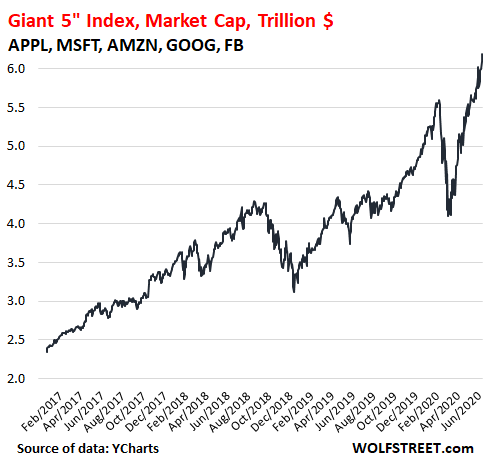
So how big did they get?
The overall stock market capitalization, as measured by the Wilshire 5000 Market Cap Index tracking 3,451 US-listed companies, ticked up to $31.8 trillion, up by 41.6% from its low on March 23.
Today, the “Giant 5” accounted for 19.4% of the total US stock market capitalization, as measured by the Wilshire 5000, a new record. On January 3, 2017, the Giant 5 had accounted for 10% of the Wilshire 5000. In the three months since the crash in March, the share of the Giant 5 has soared from abound 16% to 19.4% today (Wilshire 5000 data via YCharts):
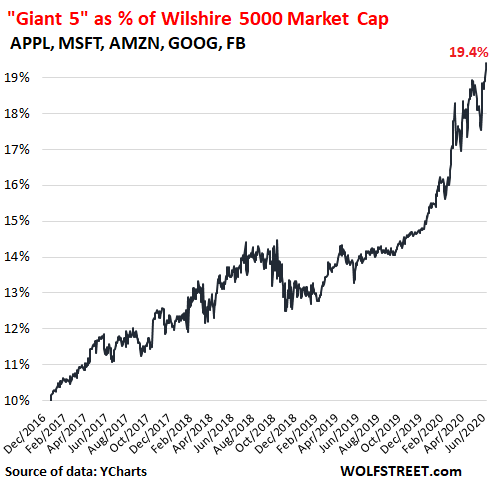
But wait… Performance of Wilshire 5000 without “Giant 5.”
Let’s take the five largest stocks out of the largest stock market in the world, with 3,451 companies, and see what’s left over. What’s left over is now valued at $25.7 trillion. It’s up by 28.4% from the March 23 low, and while that’s till strong for a three-month rally, it’s a far cry from the 51% for the Giant 5.
And here is the thing: All these companies combined, minus the “Giant 5,” are way below their peak in February 2020, and below a whole bunch of other dates before then, and below where they’d first been in at the end of January 2018.
…click on the above link to read the rest of the article…
Plot Thickens on End of QE & Start of Shedding Assets
Plot Thickens on End of QE & Start of Shedding Assets
Fed leads in trimming its balance sheet; Bank of England governor publishes the reasoning for central banks to shed assets – before raising interest rates. A big shift!
The Fed has been cutting back for weeks on its asset purchases, and on its last weekly balance sheet, its total assets actually fell by $74 billion. Now Bank of England Governor Andrew Bailey published a piece on Bloomberg Opinion today in which he wrote that these massive central-bank balance sheets – he was talking in global terms – “mustn’t become a permanent feature.”
“As economies recover, it’s likely that some of the exceptional monetary stimulus will need to be withdrawn,” he said. And this shedding of part of the bonds that had been purchased would happen before the central bank raises interest rates, he said.
This is the opposite of how the Fed did it last time: It started raising rates in December 2015 and started shedding Treasury securities and MBS in October 2017.
This time, the Fed front-loaded $2.8 trillion in QE and has already started shedding some of it even as FOMC members don’t see interest rate hikes through 2022. This is a big shift, of reducing the balance sheet first, and then raising rates.
In Bailey’s piece, there was no word of negative interest rates or yield curve control. What he is saying is that the balance sheet became the primary tool for adding stimulus and will become the primary tool for withdrawing stimulus, as interest rates remain near-zero.
And he is saying that the BOE’s balance sheet isn’t going to stay this massive for long and that it will undo some of the accommodation as the economy figures out where the new normal is.
The Fed is leading. The BOE is publishing the reasoning for other central banks to do the same.
…click on the above link to read the rest of the article…
An Epically Bad Week for US Brick-and-Mortar Retailers and Landlords
An Epically Bad Week for US Brick-and-Mortar Retailers and Landlords
Winners in this crisis: Ecommerce – for retailers that don’t sell men’s office & formal wear – and for sure, lawyers.
Tailored Brands, a holding company for men’s apparel stores, including Men’s Wearhouse and JoS. A. Bank, is considering filing for bankruptcy, according to sources cited by Bloomberg on June 8. Bankruptcy would allow the company to shut weaker locations while keeping other stores operating, the sources said.
The company confirmed in an SEC filing on June 10 that it may have to file for bankruptcy:
“If the effects of the COVID-19 pandemic are protracted and we are unable to increase liquidity and/or effectively address our debt position, we may be forced to scale back or terminate operations and/or seek protection under applicable bankruptcy laws. This could result in a complete loss of shareholder value,” it said.
But its problems started years ago, including the misbegotten $1.8 billion acquisition of JoS. A. Bank in 2014, whose revenues promptly went into a death spiral. Overall revenues fell every year since 2016.
In an update on June 10, Tailored Brands said that total revenues in the first quarter (ended May 2) collapsed by 60% year-over-year, with even ecommerce sales plunging 32%.
The company started re-opening its stores on May 7, and had 634 stores open by June 5. So how well are these reopened stores doing?
In the week ended June 5, for stores open at least the entire week, average comparable sales at Men’s Wearhouse were down 65%, at Jos. A. Bank 78%, and at K&G 40%.
That total ecommerce sales, including rental services, plunged 32% in the second quarter through June 5th – when retail has largely switched to ecommerce, and everyone else’s ecommerce sales are booming – is a sign that work-from-home has crushed demand for clothes worn to the office; and that the postponements of events such as weddings have crushed the demand for renting formal wear.
…click on the above link to read the rest of the article…
America Convulses in Pain, Fed Bails Out the Wealthy
America Convulses in Pain, Fed Bails Out the Wealthy
What’s so insidious about the Fed’s bailouts of investors in hedge funds, mortgage-REITS, stocks, bonds, leveraged loans, and other often risky assets? The destruction of capitalism.
By Wolf Richter. This is the transcript of my podcast last Sunday, THE WOLF STREET REPORT. You can listen to it on YouTube, and you can find it on iTunes, Spotify, Stitcher, Google Podcasts, and others.
We’re in an economic meltdown like I’ve never seen before. Tens of millions of people have lost their jobs – and so suddenly, that the government data to track them has fallen into chaos, with different agencies reporting data that is all over the place and contradicting each other. None of these systems were designed to track this type of sudden collapse of the labor market during a pandemic.
Then there are the many small businesses that have had to shut down or lost most of their customers and revenues. And these entrepreneurs have no idea if they can make it through this period.
Over the past three months, about 110,000 people in the United States have died from the coronavirus. That number is still growing every day at a rate of about 1,000 deaths. But the efforts to slow the spread of the virus and save lives have caused enormous economic damage.
And people’s frustration and anger with racial injustice has boiled over, and they’re frustrated and angry over a host of systemic issues, including the inequality of economic prospects, and there have been big protests every day around the country for well over a week.
…click on the above link to read the rest of the article…
Wow, That Was Fast: Debt Out the Wazoo
Wow, That Was Fast: Debt Out the Wazoo
US National Debt Spiked by $1 trillion in 5 weeks to $26 trillion. Fed monetized 65%. Business debts spike to high heaven.
Trillions are now whooshing by at a breath-taking pace. The US gross national debt – the total of all Treasury securities outstanding – jumped by $1 trillion over the past five weeks, from May 4 through June 8, and by $2.5 trillion for the 11 weeks since March 23.
The total US national debt outstanding has reached $26 trillion, according to the Treasury Department. I’ve been fretting about this debt on my site since 2011. In recent years, I innocently added a green upward arrow with “Debt out the wazoo” to my gross-national-debt charts, unaware that this tongue-in-cheek label would turn into a factual, data-based technical term:
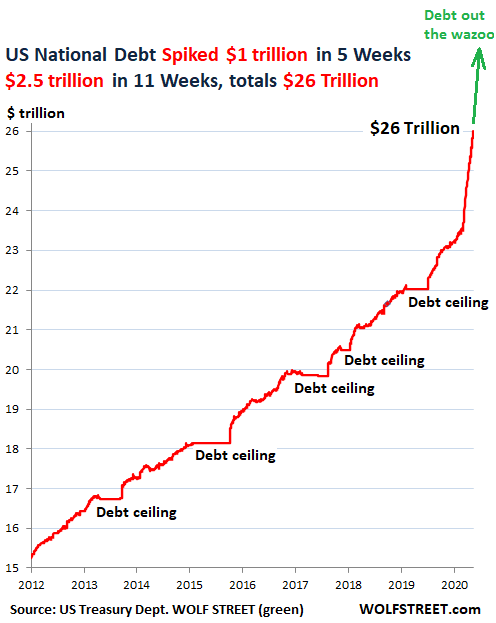
And think about this: The huge mountain of debt that took decades to grow to this gargantuan size has exploded by another 10% in just 11 weeks.
The curious flat spots in the chart are the periods when the national debt bounced into the Congress-imposed debt ceiling. During these periods, the government borrowed from federal pension funds and other internal sources – the “extraordinary measures” – to make ends meet, thereby continuing to borrow, and when the political charade was resolved and the debt ceiling was raised, bam, the debt jumped by hundreds of billions in weeks. Now the debt jumps by the trillions in weeks on a routine basis.
On February 19, when the debt had soared by $1.3 trillion in 12 months to $23.3 trillion, I mused: “But these are the good times. And we don’t even want to know what this will look like during the next economic downturn.”
Turns out, we didn’t get a regular economic downturn. We got the most epic and sudden economic downturn ever. And now we’re beginning to know what this looks like in terms of the US debt.
Fed monetizes 65% of the additional debt.
…click on the above link to read the rest of the article…
The Chilling Things Delta Said about the Airline Business, the 90% Collapse in Q2 Revenues, and Why Some Demand Destruction May Be “Permanent”
The Chilling Things Delta Said about the Airline Business, the 90% Collapse in Q2 Revenues, and Why Some Demand Destruction May Be “Permanent”
Shares go to heck after the mother of all revenue-warnings, plunge 20% in two days, including 7% after hours. Its disclosure confirms Buffett’s decision to dump his airlines in mid-crash.
Delta Airlines came out with the mother of all revenue-warnings when it said in an SEC filing this morning that its revenues in the second quarter, ending June 30, would collapse by 90% compared to the second quarter last year.
In addition to the collapse of demand, it has “experienced significant ticket cancellations” (refunds are counted as negative revenues), and it has waved change fees, which used to be a big profit center, and it is giving out “other refunds,” and they all “have negatively affected our revenues and liquidity, and we expect such negative effects to continue.”
And it cannot predict the effects of this unpredictable future, not even the near-term effects. “The longer the pandemic persists, the more material the ultimate effects are likely to be,” Delta said. “It is likely that there will be future negative effects that we cannot presently predict, including near term effects.”
It added a slew of dismal data points and warnings, along with the hoops it has already jumped through and still needs to jump through to stay in business, including billions of dollars in help from the taxpayer. It was a doom-and-gloom report that not even a sworn doom-and-gloomer would have been able to imagine not too long ago.
Delta’s shares dropped 7.4% during regular hours, and another 7.0% after hours, to $29.40, after having already dropped 7.6% yesterday. It seems, some people knew yesterday what Delta would announce this morning. Over those two days combined, including after hours today, shares have plunged 20.3%.
…click on the above link to read the rest of the article…
What Horrified Fund Managers, Banks & UK’s Pension Minister Said About the Bank of England’s Sudden “We Don’t Rule Out” Negative Interest Rates
What Horrified Fund Managers, Banks & UK’s Pension Minister Said About the Bank of England’s Sudden “We Don’t Rule Out” Negative Interest Rates
“The stimulus the country urgently needs is not experimental and dangerous monetary policy.”
Andrew Bailey, the recently appointed governor of the Bank of England (BoE), is considering going where no other BoE governor has ever gone in the central bank’s 325-year history: into negative interest rate territory. On May 20, Bailey told British MPs that the BoE is refusing to rule out cutting the benchmark interest rate below zero in response to the virus crisis.
“We do not rule things out as a matter of principle. That would be a foolish thing to do,” Bailey told MPs. “But that doesn’t mean we rule things in either.”
That statement came just six days after Bailey had told FT readers that negative interest rates are “not something we are currently planning for or contemplating.” Since then, Bailey says he has “changed [his] position a bit.”
Bailey, who replaced Mark Carney as BoE governor just two months ago, is not the only senior BoE official who’s apparently warming to the idea of foisting negative interest rates on the British economy.
So, too, has the central bank’s chief economist Andrew Haldane, who last week said: “The economy is weaker than a year ago and we are now at the effective lower bound, so in that sense it’s something we’ll need to look at – are looking at – with somewhat greater immediacy. How could we not be?”
In the wake of the virus crisis, the Bank of England has already slashed interest rates by 0.65 basis points to 0.1%, its lowest level ever. It has also revved up its swap lines with the Federal Reserve and other central banks, offered billions of pounds of fresh liquidity support to banks, and expanded its QE program by £100 billion to £745 billion and extended what it buys to include corporate bonds.
…click on the above link to read the rest of the article…
Week 9 of the Collapse of the U.S. Labor Market: Still Getting Worse at a Gut-Wrenching Pace
Week 9 of the Collapse of the U.S. Labor Market: Still Getting Worse at a Gut-Wrenching Pace
Federal Pandemic Unemployment Assistance (PUA) for gig workers doubles initial claims under state programs. Here are the “Insured Unemployment Rates” for each of the 50 states & DC.
The moment the unemployment crisis stops getting worse and bottoms out would signal the beginning of a recovery of the job market. But instead, it’s still getting worse at a gut-wrenching pace.
In the week ended May 16, state unemployment offices processed 2.438 million “initial claims” for unemployment insurance under state programs, bringing the total number of initial claims over the past nine reporting weeks since mid-March to a mind-bending 38.6 million (seasonally adjusted). The claims reported by the US Department of Labor this morning were over three times the magnitude of the prior weekly records during the unemployment crises in 1982 and 2009.
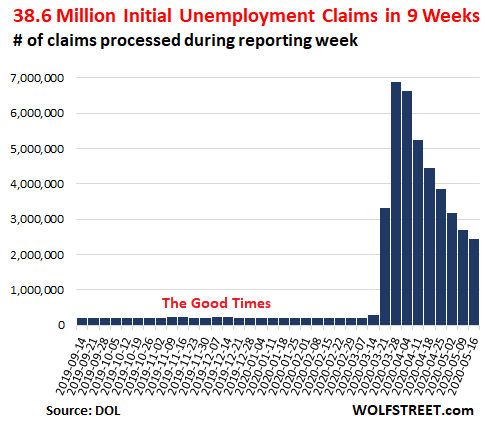
But it’s even worse: 4.4 million initial claims with PUA.
These “initial claims” exclude the gig workers, self-employed, and contract workers who are now eligible to receive unemployment insurance under the special and temporary federal program in the stimulus package, called Pandemic Unemployment Assistance (PUA).
In the week ended May 16, an additional 2.23 million people (not seasonally adjusted) filed initial claims under the PUA program, up from the 850,000 that had filed the week ended May 9, and the 1 million that had filed in the week ended May 2. So in total, when regular initial claims (not seasonally adjusted) and PUA initial claims are combined for the week ended May 16, the total of initial claims (not seasonally adjusted) more than doubles to 4.4 million.
The number of “Insured Unemployed” spikes after last week’s calm.
…click on the above link to read the rest of the article…
A Word About the Current Chaos in Prices and Inflation
A Word About the Current Chaos in Prices and Inflation
Some prices collapsed, others skyrocketed, and the Consumer Price Index went haywire. Here’s what I’m seeing beyond the near term — and it’s not “deflation.”
Amid soaring prices of meat, beverages, fruit, veggies, and other food at home, and surging costs of personal goods, medical care services, and household furnishings, and amid a collapse in prices of gasoline, car rentals, public transportation, car insurance, lodging away from home, and other things – amid these diametrically opposed price movements, the Consumer Price Index went, as expected, haywire today. And we’re going to look at some of those gyrations beyond it.
First, here’s what got buffeted around:
The overall Consumer Price Index fell 0.8% in April from March, the steepest one-month drop since December 2008, when the economy was going through peak-Financial-Crisis 1. This brought the increase over the past 12 months down to 0.3%, the lowest since October 2015 during the oil bust at the time.
The “core” CPI – CPI without the volatile food components and the extremely volatile energy components – dropped 0.5% from March to April but was still up 1.4% from a year ago.
But wait…
What if we take out the most chaotic and largely temporary price movements at both ends to get to what the undying loss of the purchasing power of the dollar might be? Because that’s what consumer price inflation is.
There is a consumer price index that is not buffeted around by the month-to-month collapse of some prices and surge in other prices; The Cleveland Fed’s “Median CPI,” which is based on the data from the CPI, removes the extremes at both ends since these extremes are often temporary and distort long-term inflation trends.
…click on the above link to read the rest of the article…
US National Debt Spiked by $1.5 trillion in 6 Weeks, to $25 trillion. Fed Monetized 90%
US National Debt Spiked by $1.5 trillion in 6 Weeks, to $25 trillion. Fed Monetized 90%
I’d never imagined I’d ever see this sort of spike, though in recent years I added an upward arrow with “Debt out the wazoo” to my charts, not realizing just how factually accurate this technical term would become.
The US gross national debt – the total of all Treasury securities outstanding – jumped by $1.05 trillion with a T in the four weeks since April 7 and by $1.54 trillion in the six weeks since March 23, to $25.06 trillion, the Treasury department reported today.
Those trillions are whizzing by so fast it’s hard to even seen them. WOOSH… What was that? Oh, just another trillion. The flat spots in the chart are the periods when the debt bounced into the debt ceiling. Yeah, those were the days!
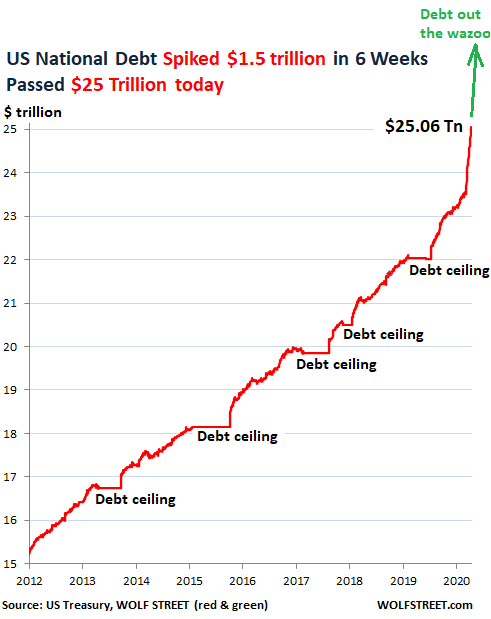
I’ve been lamenting and lambasting the stupendous growth of the US national debt since 2011, the beginning of my illustrious career as a gnat in the big world of financial media. And through all these years, I’d never imagined that I’d ever see this sort of spike in the US debt, though in recent years I’ve been adding an upward arrow and the green label “Debt out the wazoo” to these charts, not realizing just how factually accurate this technical term would become.
The US debt was even surging at an accelerating rate during the “Best Economy Ever,” when there should have been a surplus and a reduction in the debt, so that the government can go into debt during bad times.
I wrote back then, for example on February 19, when the debt had spiked by $1.3 trillion over the past 12 months to $23.3 trillion: “But these are the good times. And we don’t even want to know what this will look like during the next economic downturn.”
…click on the above link to read the rest of the article…
THE WOLF STREET REPORT: Nothing’s Fixed – What’s Behind the Corporate Debt Bailout
THE WOLF STREET REPORT: Nothing’s Fixed – What’s Behind the Corporate Debt Bailout
Over the past two years, nobody knew what would trigger the next financial crisis, but just about everyone knew it would involve the record pile of corporate debt. And so it happened. Now the Fed fixed it…
European Banks Reveal Scale & Complexity of Crisis. Shares Hammered Back to 1987 Level
European Banks Reveal Scale & Complexity of Crisis. Shares Hammered Back to 1987 Level
They haven’t gotten over Financial Crisis 1 and the Euro Debt Crisis. Now there’s a new crisis. Deutsche Bank’s CEO going on TV to soothe nerves didn’t help matters.
The biggest European banks have started to report their earnings against a bleak backdrop of locked down economies, plunging economic activity, surging business closures and rising loan defaults. Each earnings call laid bare the scale, scope and complexity of the problems and challenges facing a European banking sector that never really recovered from their last two crises — the Global Financial Crisis followed by the Euro Debt Crisis.
The Stoxx 600 Banks index, which covers major European banks, fell 4.5% on Thursday. Today, continental European stock markets were closed (May Day), but the London Stock Exchange was open, and the index ticked down another 1% (to 88.8). The Stoxx 600 Banks index has already collapsed by 40% since Feb 17, when the Coronavirus began spreading through northern Italy. After the initial 40%-plus plunge in late February and early March, the index has remained in the same dismally low range:
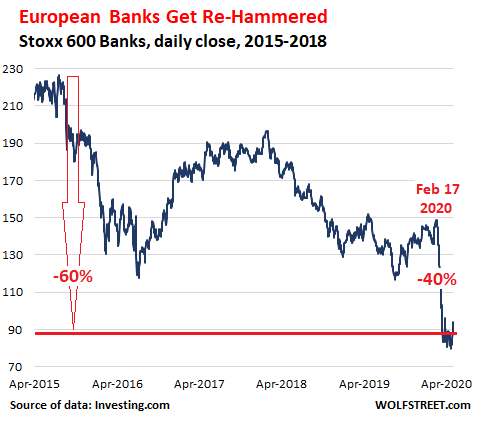
On April 21, the Stoxx 600 Banks Index had closed at 79.8, down 83% since its peak in May 2007, and the lowest since 1987. The following day, the ECB announced it was going to accept junk bonds as collateral when banks borrow from it. Yesterday, the ECB was excepted to go even further and announce that it would actually buy junk-rated bonds, as the Federal Reserve announced a few weeks ago. But the ECB didn’t announce it, and the Fed hasn’t bought any junk bonds yet either.
…click on the above link to read the rest of the article…
Bone-Chilling WTF Charts of the Collapse in US Demand for Gasoline, Jet Fuel, and Diesel
Bone-Chilling WTF Charts of the Collapse in US Demand for Gasoline, Jet Fuel, and Diesel
It started in mid-February for jet fuel and in mid-March for gasoline.
Oil companies are reporting financial fiascos every day: Today Exxon reported its first quarterly loss since 1999 ($610 million), on a “market-related” $2.9 billion write-down. “We’ve never seen anything like what the world is facing today,” CEO Darren Woods said.
On Thursday, Texas-based shale-driller Concho Resources reported a quarterly loss of $9.3 billion, after writing down the value of its oil and gas assets by $12.6 billion.
Also on Thursday, it was reported that Oklahoma-based Chesapeake Energy, a pioneer in shale-drilling, was preparing to file for bankruptcy (what’s taking so long?).
Still on Thursday, Royal Dutch Shell shocked the markets when it announced that it would reduce its dividend for the first time since 1945 (by 66% from $0.47 to $0.16). “The duration of these impacts remains unclear with the expectation that the weaker conditions will likely extend beyond 2020,” the statement said. The already beaten-up shares plunged another 17% in two days. Shares are down 47% year to date.
Earlier in April, among the oil companies that have already filed for bankruptcy, were two high-profile oil drillers, Whiting Petroleum and Diamond Offshore Drilling.
The drama is centered on the collapse in demand for crude oil. Crude oil is primarily used for two purposes: transportation fuel and as feedstock for the chemical industry. Even before the crisis, demand growth has been weak, particularly as transportation fuel in developed countries. But production has been surging, and amid ample and growing supply, prices were already weak, when the coronavirus hit.
Demand for transportation fuel in the US collapsed.
…click on the above link to read the rest of the article…
Fed Drastically Slashed Helicopter Money for Wall Street. QE Down 86% From Peak Week in March
Fed Drastically Slashed Helicopter Money for Wall Street. QE Down 86% From Peak Week in March
Fed shed MBS. Loans to “SPVs” flat for fifth week. Repos in disuse. Fed still hasn’t bought junk bonds, stocks, or ETFs. But it sure sent Wall Street dreaming.
Total assets on the Fed’s balance sheet rose by only $83 billion during the week ending April 29, to $6.656 trillion. That $83 billion was the smallest weekly increase since this show started on March 15, and down by 86% from peak-bailout in the week ended March 25. This chart shows the weekly increases of total assets on Fed’s balance sheet:
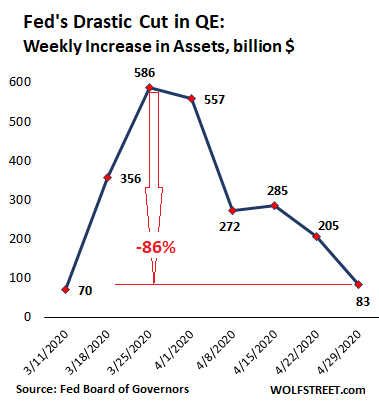
The Fed is thereby following its playbook laid out over the past two years in various Fed-head talks that it would front-load the bailout-QE during the next crisis, and that, after the initial blast, it would then cut back these asset purchases when no longer needed, rather than let them drag out for years.
On January 1, the balance sheet stopped expanding as the Fed’s repo market bailout had ended. However, in late February, all heck was breaking loose, and the Fed first increased its repo offerings and then on March 15, started massively throwing freshly created money at the markets, peaking with $586 billion in the single week ended March 25.
But since then, the Fed has slashed its weekly increases in assets, which shows up in the flattening curve of the Fed’s total assets in 2020:
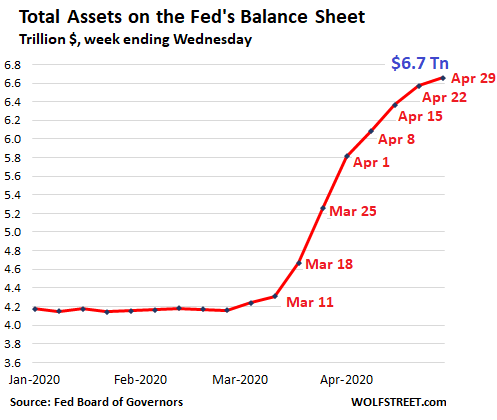
The Fed cut its purchases of Treasury securities. The balance of its mortgage-backed securities (MBS) actually fell. Repurchase agreements (repos) have fallen into disuse. Lending to Special Purpose Vehicles (SPVs) has not gone anywhere in five weeks. And foreign central bank liquidity swaps, after spiking in the first two weeks, only rose modestly, with most of the increase coming from the Bank of Japan, which is by far the largest user of those swaps.
…click on the above link to read the rest of the article…
How Far Will the U.S. Economy Plunge During Lockdown?
How Far Will the U.S. Economy Plunge During Lockdown?
“Three times deeper than the Great Recession?”
No one has ever been through an economy where enormous shifts have occurred, from one day to the next, shutting down part of the economy but also generating sectors that are vastly more vibrant than ever before. Monthly or quarterly economic indicators leave us in the dark because they lag too far behind and are at the moment largely useless. What we need is high-frequency data – daily and weekly that track this shifting economy in near-real time.
For example, there has been an enormous boom in ecommerce – but we won’t get ecommerce data for Q1 until mid-May and for Q2 until August. Best Buy reported last week that its online sales had surged by 250% but that it would furlough 51,000 hourly store employees as stores were closed to customers, allowing only for curbside pickup. That duality that is now widespread impacts the economy in strange ways.
Grocery store and supermarket sales – which are normally the epitome of slow and steady growth tied to inflation and population growth – are suddenly booming. Kroger reported a 30% surge in “identical retail supermarket sales without fuel.”
Anything having to do with working-at-home, including hardware sales, is booming. Everything and anything that is online is booming — as are the sectors that make it all work, including delivery services. And there are other sectors that are suddenly hot.
But other parts of the economy have essentially collapsed, with near-zero revenues, such as sit-down restaurants, sports & entertainment events, or the entire travel and accommodations industry, including airlines and hotels.
Some manufacturing plants are operating, but many others are not. Much of the construction industry has shut down. Housing and auto sales are still ongoing, but at far lower levels.
…click on the above link to read the rest of the article…



